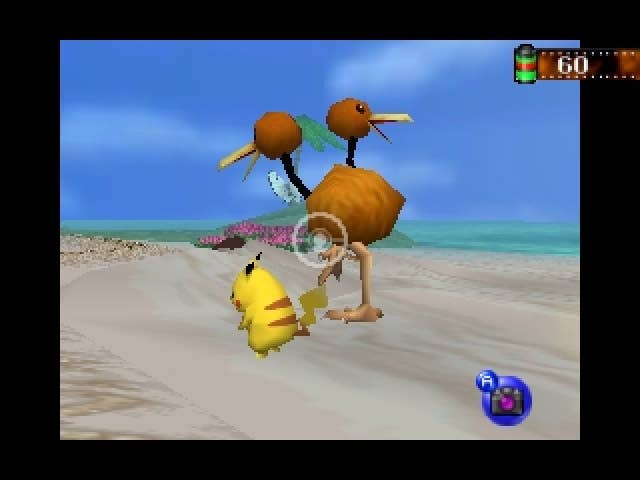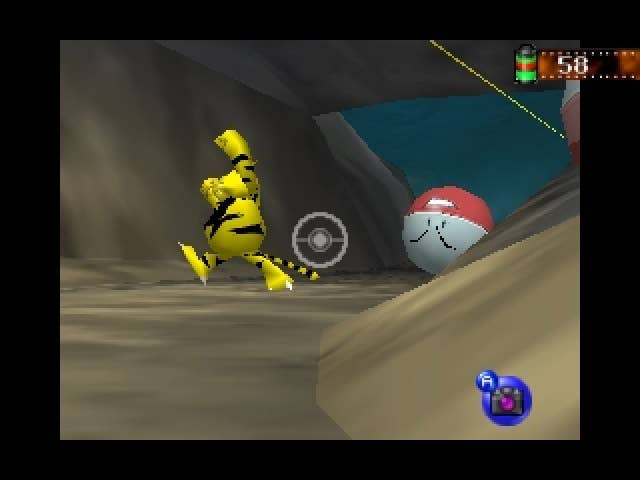Capitalizing on a Lucky Break With Pokémon Snap
Nintendo's RPG-turned-global-phenomenon helped keep things looking rosy in tough times.
This article first appeared on USgamer, a partner publication of VG247. Some content, such as this article, has been migrated to VG247 for posterity after USgamer's closure - but it has not been edited or further vetted by the VG247 team.
Nintendo built its '80s console empire on a foundation comprised of two elements: Great software and cunning business practices. The former made the company a lot of fans, and the latter made them a lot of money... but not a lot of allies.
By the time the Nintendo 64 console had reached its middle age, most of the third-party publishers that once graced the NES and Super NES with games both good and terrible had jumped ship in search of more fruitful ways to do business. Nintendo's strict licensing terms, self-centered publishing policies, and determination to stick with the cartridge format in the face of an industry-wide shift to CD media turned N64 into a ghost town even as a record number of games appeared on Sony's PlayStation.
The N64's carts may have been an artistically motivated choice -- Nintendo's designers supposedly wanted to avoid the lengthy loading times that affected CD-based games -- but they amounted to business suicide. They offered incredibly limited storage space compared to CDs; they raised the costs of development (simply porting Resident Evil 2 to N64 cost a million dollars in an era where top-tier games rarely cost more than $2-3 million); and they caused N64 games to retail for $20-40 more than comparable PS1 games. N64 was bad business for everyone, including Nintendo... and it came right on the heels of the disastrous Virtual Boy.

Yes, the late '90s were a dark time for Nintendo, which a mere decade before had clutched the whole of the console gaming industry in a vice-like grip. The N64 era could have been the end of the legacy that began with the NES if not for a massive lucky windfall: The wild, runaway success of Pokémon. An unassuming role-playing game that launched quietly in Japan in 1995 for the slowly fading Game Boy handheld, Pokémon snowballed into a juggernaut through word of mouth. By the time Nintendo and Game Freak had reworked the patchy Japanese original for international release, three years later, Pokémon was a brand consisting not only of a game but also of toys, cartoons, cards, and more -- all of which arrived in concert with the Western versions of the game. The simultaneous onslaught sparked an instant global hit, selling millions of games and untold amounts of merchandise. While Nintendo didn't exclusively own the Pokémon brand, they held enough of a stake to rake in a huge fortune from the franchise's international popularity. That windfall helped keep things in the black for the company even as its marketshare shrank. And it had a side benefit, too: The Game Boy, that aging and technologically primitive handheld, suddenly got a new lease on life.
Nintendo was quick to take the Pokémon series beyond the limited bounds of the Game Boy. While the core games have remained handheld-based to this day, the character-driven nature of the franchise lent itself to any number of interpretations. On one hand, you had something like Pokémon Battle Stadium, which reduced the RPG concept down to a series of arena-based battles. On the another, you had the far more intriguing Pokémon Snap.
Pokémon fans have clamored for the core RPGs to come to consoles for as long as the franchise has been around -- some feel the series is too good to languish in the "handheld ghetto." Snap disappointed those players by very decidedly not reproducing the RPG design of Pokémon Red and Blue on N64. It's a very different kind of game -- and, truth be told, a far more memorable one than a mere graphical overhaul of a Game Boy adventure would have been.

The idea behind Pokémon Snap wasn't really to go on a grand adventure in the world of Pokémon. Instead, it focused on the creatures themselves in a highly restrictive format that nevertheless demanded high-level play. Game Freak had created 151 unique monsters for their game, but in practice they amounted to little more than a collection of statistics for combat with the occasional in-world cameo for the sake of window dressing. Snap turned the focus entirely away from fighting, giving fans a glimpse of how pokémon behaved in the wild and how those wild combat powers translated into more mundane situations.
Snap's appeal came from the same place as that of the pokémon anime: It took the games, whose universe and characters were depicted with monochromatic minimalism, and rendered those concepts in more elaborate detail. Unlike the cartoon, however, Snap wasn't shackled to the misadventures of a dopey kid and his pet rat. Instead, it allowed players to enter the world of Pokémon for themselves and see the creatures interacting on their own: A virtual safari full of fantastic beasts.
Just as Pokémon Red and Blue could only really work on Game Boy -- this was around the time NCL President Hiroshi Yamauchi excoriated RPGs for appealing to shut-ins, putting his money where his mouth was by offering an RPG that actively fostered socialization through Game Boy's portability and connectivity -- so too could Snap only have worked on N64. The cramped confines of a cartridge wouldn't have been sufficient to contain games as expansive as the Pokémon RPGs in proper 64-bit 3D, but they had more than enough room for a simple on-rails safari adventure -- albeit one that didn't include even half the total pokémon species from the franchise's first generation.

Truth be told, Snap was basically little more than a rail shooter. The difference was that rather than shooting pokémon with guns, players shot them with cameras. This created a different form of challenge than the typical kill-or-be-killed take on the genre, encouraging players not to dominate enemies but rather to excel artistically. Given only a few film roll's worth of shots, how could you best frame each one? Timing, focus, and zoom mattered, and players were scored at the end of each journey to grade their talents as a camera master.
Snap even took on a life of its own through the Pokémon Snap Station, a location-based kiosk service that allowed fans to load up their Snap saves and create stickers from them. For a Pokémon-obsessed kid, it was the equivalent of taking their vacation pictures to the one-hour photomat.
The strangest thing about Pokémon Snap is that there's never really been a proper follow-up despite its popularity. One might think the 3DS, with its gyroscopic motion sensor and AR features, would offer a perfect home for a Pokémon Snap 2. With 10 times as many creatures available in the current generation as were present in the original Snap, there's certainly no shortage of opportunities for original photo scenarios. But as a historical artifact, Snap embodies Nintendo's savvy: Shoring up a weakness in one area by capitalizing on a popular brand in an unexpected but entertaining way. It'll be interesting to see if they can recapture that magic with next week's strategy update announcements.








